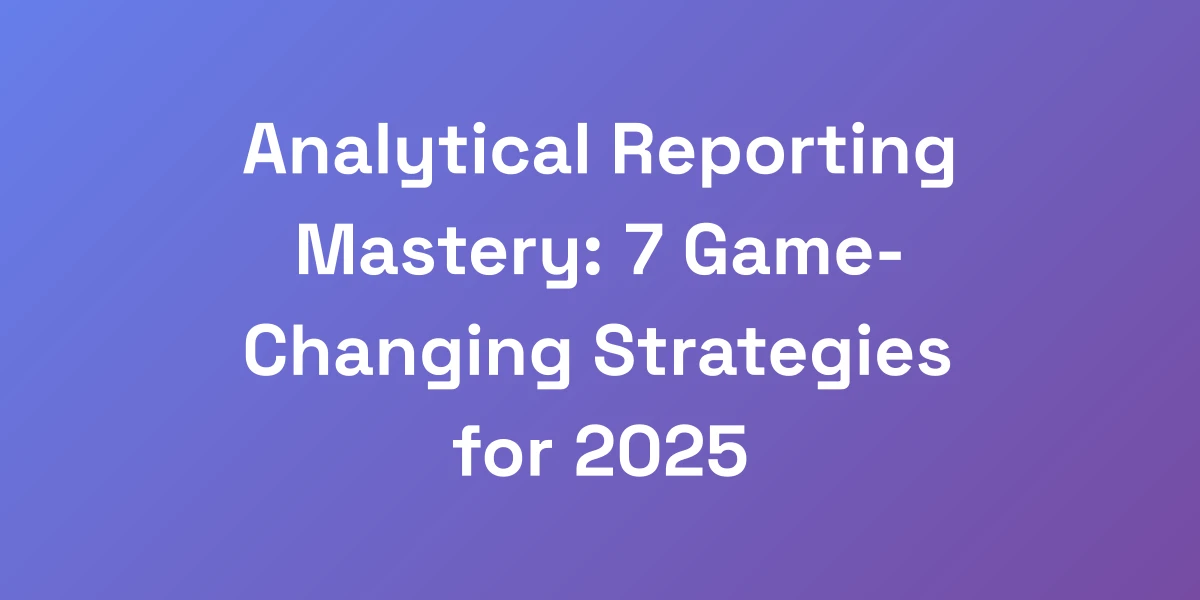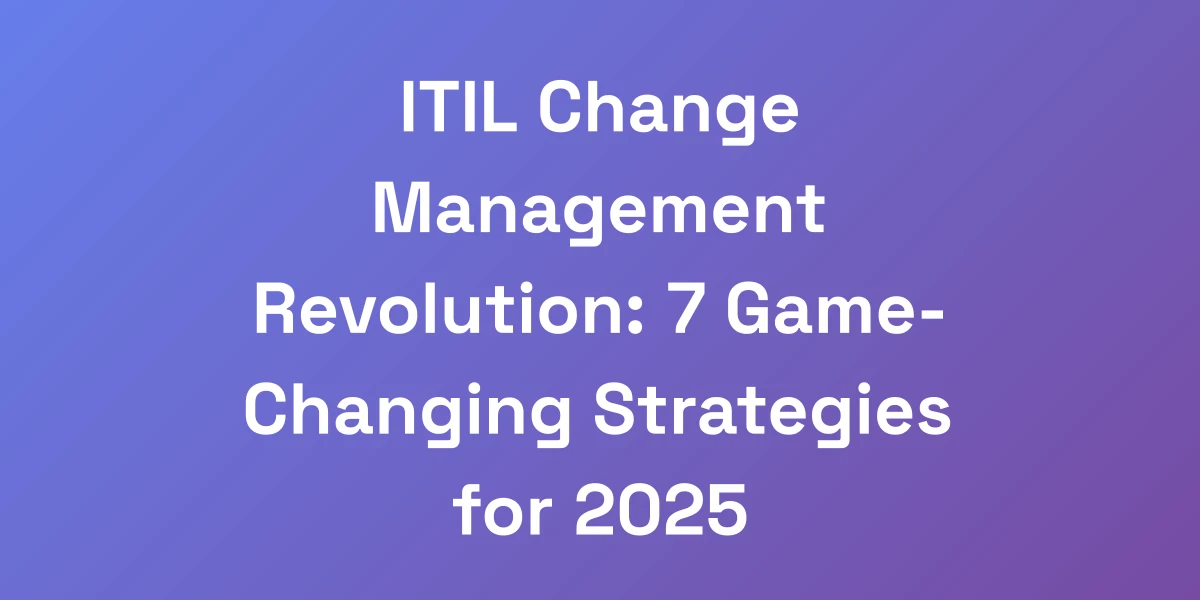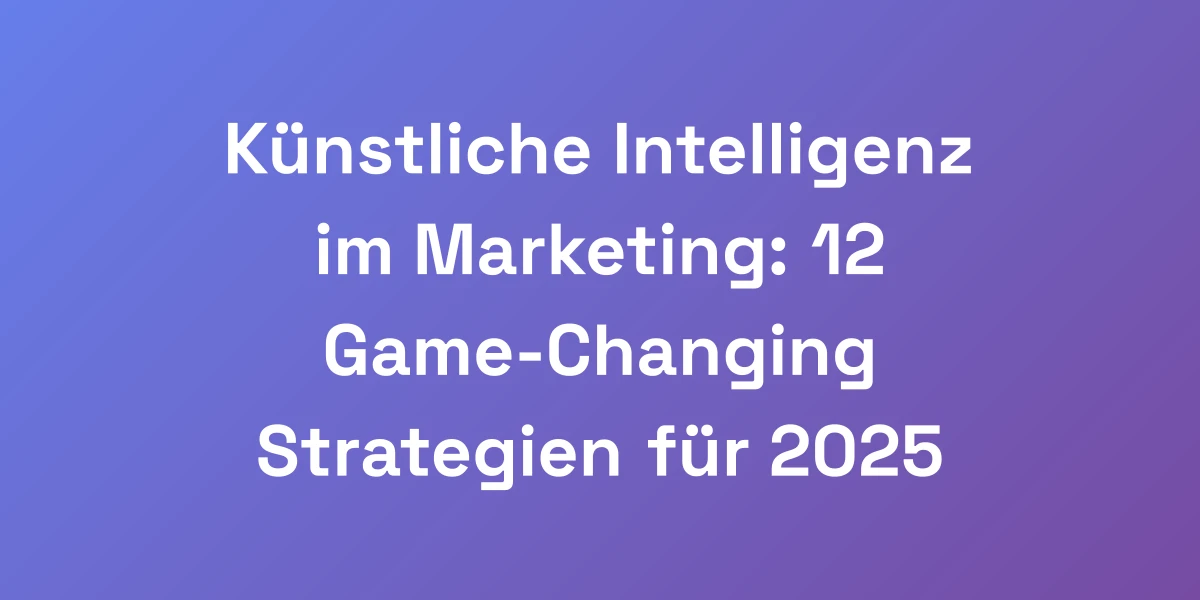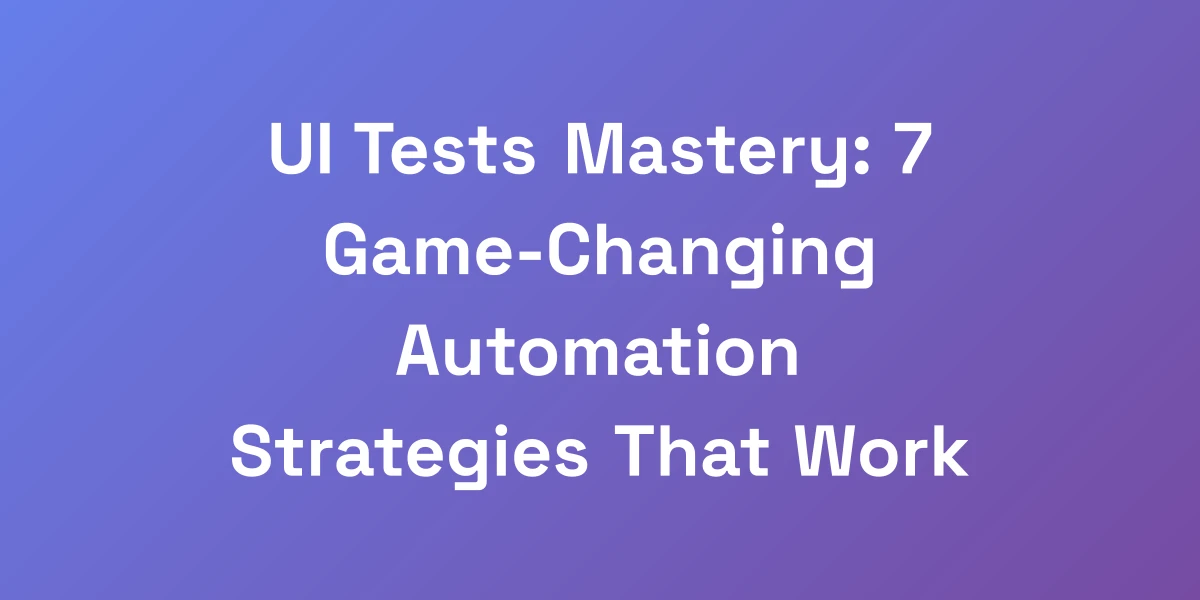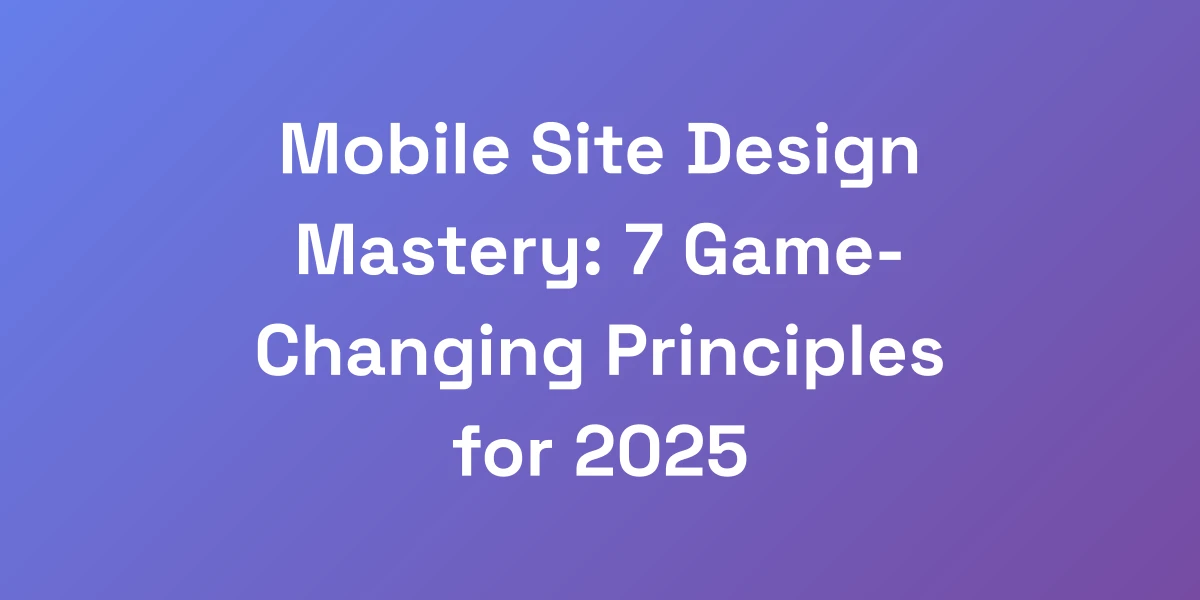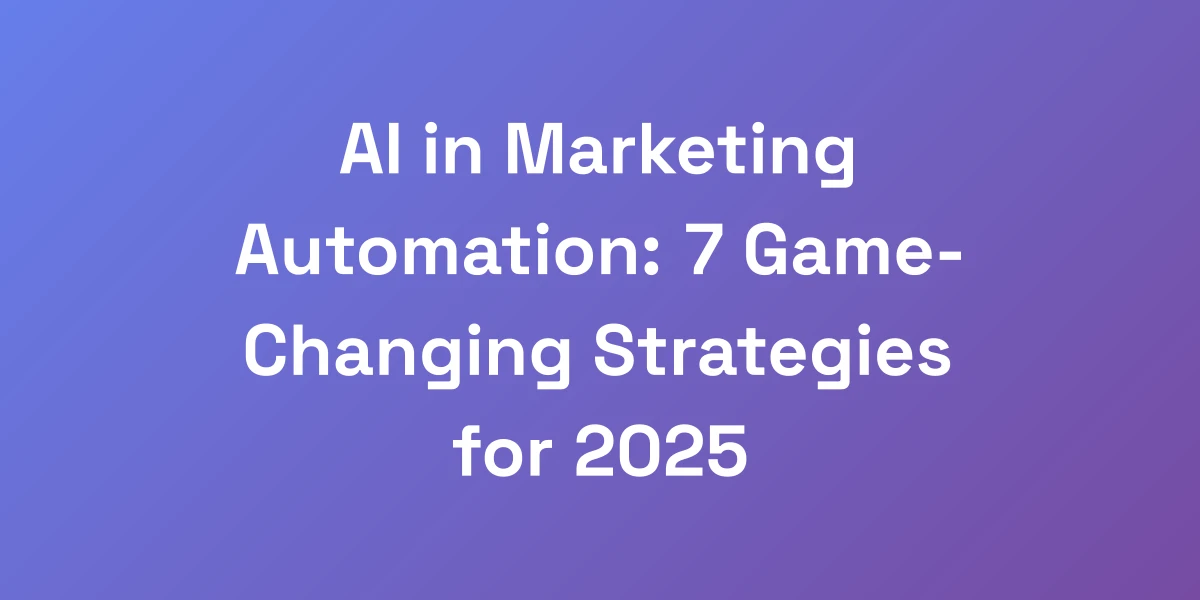
AI in Marketing Automation: 7 Game-Changing Strategies for 2025
Mar 23, 2025 | By [email protected]
Introduction
Let’s get real: the marketing game has changed, and if you’re not leveraging AI for marketing automation, you’re stuck in the past. We’re living in an era where AI isn’t just a tool—it’s the backbone of successful marketing strategies. Think about it: businesses integrating AI-driven automation are seeing 10x their conversion rates, while others are scrambling to catch up. Why? Because AI offers a precision and efficiency that traditional methods simply can’t match.
But here’s the kicker: most of your competitors haven’t fully tapped into AI’s potential yet. They’re still relying on outdated systems that leave money—and opportunities—on the table. We’re here to change that. In this article, we’ll dive deep into seven game-changing AI strategies that will redefine your marketing automation approach by 2025. Get ready to transform your marketing efforts, scale like never before, and dominate your market.
The Evolution of Marketing Automation: Why AI is Your Secret Weapon
Traditional Marketing Automation vs. AI-Powered Systems
Traditional marketing automation systems are like basic calculators—simple and reliable but limited in scope. They handle repetitive tasks like email scheduling and basic segmentation. However, they lack the intelligence to adapt and optimize in real-time.
Enter AI-powered systems. These are the supercomputers of marketing automation. They analyze vast amounts of data, predict customer behaviors, and personalize interactions on a scale that humans simply can’t achieve. This shift from basic automation to intelligent automation is not just an upgrade—it’s a complete transformation.
- Efficiency: AI systems can manage and optimize multiple campaigns simultaneously without fatigue.
- Personalization: They deliver hyper-personalized content based on real-time data insights.
- Scalability: AI-driven platforms easily scale with your business growth, maintaining performance and accuracy.
By adopting AI-powered systems, we’re not just automating tasks; we’re building a dynamic, responsive marketing machine that adapts and evolves with your business needs.
The ROI Revolution: Real Numbers Behind AI Implementation
Let’s talk numbers. Investing in AI in marketing automation isn’t just a cost—it’s a profitable investment. On average, marketing automation returns $5.44 for every dollar spent within the first three years. This isn’t some pie-in-the-sky figure; it’s backed by real-world data.
Consider this: businesses implementing AI-driven automation have reported up to a 40-60% reduction in customer acquisition costs. How? By targeting the right audience with precision, optimizing campaigns in real-time, and eliminating wasted spend on ineffective strategies.
- Enhanced Targeting: AI algorithms analyze customer data to identify and target high-value prospects.
- Real-Time Optimization: Campaigns are continuously adjusted based on performance metrics, ensuring maximum ROI.
- Resource Allocation: Budgets are allocated more efficiently, focusing on strategies that yield the highest returns.
These numbers aren’t just impressive—they’re a testament to the transformative power of AI in driving profitability and growth.
Key Players Reshaping the Marketing Automation Landscape
The market is buzzing with AI-driven marketing automation tools, each bringing something unique to the table. Leaders like Salesforce, Salesloft, and Zapier are setting the standard for what’s possible.
- Salesforce: Utilizes AI for customer relationship management and predictive analytics, helping businesses forecast trends and customer needs.
- Salesloft: Offers comprehensive sales engagement automation, including email and call automation, enhancing the efficiency of sales teams.
- Zapier: Excels in integrating various applications to automate complex workflows, streamlining operations across departments.
- Salesmate: Focuses on automating repetitive tasks and personalizing customer experiences, allowing businesses to scale their efforts efficiently.
- HubSpot AI: Provides an all-in-one platform with AI-driven content creation and CRM enhancements, offering a holistic approach to marketing automation.
These tools are more than just software—they’re game-changers that redefine how we approach marketing automation, pushing the boundaries of what’s achievable.
Why Most Businesses Fail at AI Integration (And How to Avoid It)
Despite the clear benefits, many businesses stumble when it comes to integrating AI into their marketing strategies. Why? It’s often a matter of improper implementation and unrealistic expectations.
- Lack of Strategy: Jumping into AI without a clear strategy leads to scattered efforts and wasted resources.
- Data Quality: Poor data quality undermines AI’s effectiveness. Clean, relevant data is crucial for meaningful insights.
- Resistance to Change: Organizational resistance can hinder the seamless adoption of AI technologies.
So, how do we avoid these pitfalls? Here are some actionable tips:
- Define Clear Objectives: Establish what you aim to achieve with AI, whether it’s increasing engagement, improving ROI, or reducing costs.
- Invest in Quality Data: Ensure your data is accurate, comprehensive, and relevant to maximize AI’s potential.
- Foster a Culture of Innovation: Encourage your team to embrace new technologies and continuously seek improvements.
- Start Small: Begin with pilot projects to test AI applications and scale gradually based on success.
By approaching AI integration strategically, we can harness its full potential and drive substantial growth.
Predictive Analytics: The Foundation of AI-Driven Marketing
Building Your Predictive Analytics Framework
Predictive analytics is the bedrock of AI-driven marketing. It’s not about crystal balls—it’s about leveraging data to shape outcomes. Building a robust predictive analytics framework involves several key steps:
- Data Collection: Gather comprehensive data from various sources, including CRM systems, social media, and website analytics.
- Data Cleaning: Ensure the data is free from errors, duplicates, and inconsistencies for accurate analysis.
- Model Selection: Choose the right AI models that align with your marketing goals, whether it’s regression, classification, or clustering.
- Implementation: Integrate predictive models into your marketing workflows to start driving insights and actions.
By meticulously constructing your predictive analytics framework, we lay the foundation for intelligent decision-making that propels marketing success.
Customer Behavior Modeling That Actually Works
Understanding customer behavior is more complex than just tracking clicks and conversions. It’s about creating detailed models that predict future actions based on past behavior. Here’s how:
- Segmentation: Divide your audience into precise segments based on demographics, preferences, and behaviors.
- Pattern Recognition: Use AI to identify patterns and trends in customer interactions and transactions.
- Prediction: Forecast future behaviors like purchasing intent, churn likelihood, and product preferences.
Effective customer behavior modeling enables us to anticipate needs and tailor our marketing efforts to meet those demands proactively.
Scoring and Prioritizing Leads with AI
Not all leads are created equal. AI can help us score and prioritize leads based on their likelihood to convert, ensuring we focus our efforts where they matter most.
- Lead Scoring Models: Develop models that assign scores to leads based on engagement, demographics, and behavior indicators.
- Prioritization: Focus on high-scoring leads that are more likely to convert, optimizing sales efforts.
- Automation: Automate the lead scoring process to ensure real-time updates and seamless integration with sales workflows.
By effectively scoring and prioritizing leads, we can enhance our sales funnel efficiency and drive higher conversion rates.
Creating Dynamic Customer Journey Maps
Static customer journey maps fail to capture the dynamic nature of customer interactions. AI enables us to create dynamic maps that adapt in real-time based on customer behavior and feedback.
- Real-Time Data Integration: Continuously update journey maps with the latest customer data to reflect current behaviors and preferences.
- Personalized Touchpoints: Identify and optimize key touchpoints to deliver personalized experiences at every stage of the journey.
- Adaptive Strategies: Modify marketing strategies on the fly based on real-time insights and shifting customer needs.
Dynamic customer journey maps ensure that our marketing strategies remain relevant and effective, fostering stronger customer relationships and loyalty.
Implementation Strategies for Different Business Sizes
Whether you’re a small startup or a large enterprise, implementing predictive analytics requires tailored strategies to fit your unique needs and resources.
- Small Businesses: Start with affordable, scalable AI tools that offer core predictive capabilities. Focus on high-impact areas like lead scoring and basic personalization.
- Medium Enterprises: Invest in more advanced AI platforms that provide deeper insights and broader integration across multiple marketing channels.
- Large Corporations: Leverage comprehensive AI-driven analytics suites that can handle vast amounts of data and offer sophisticated modeling and forecasting options.
By customizing our approach based on business size and capacity, we ensure a smooth and effective implementation of predictive analytics that aligns with our growth objectives.
Hyper-Personalization: The New Standard in Customer Engagement
Building Dynamic Content Engines
Content is king, but not just any content—it needs to be hyper-personalized. Dynamic content engines powered by AI can create and deliver content tailored to individual user preferences and behaviors in real-time.
- Content Customization: Automatically generate content variations based on user data and interaction history.
- Personalized Recommendations: Deliver product or content recommendations that align with each user’s unique interests.
- Adaptive Content Delivery: Adjust the type, format, and timing of content delivery to maximize engagement.
With dynamic content engines, we can deliver highly relevant content that resonates with each customer, driving deeper engagement and higher conversion rates.
Real-Time Personalization Algorithms
Personalization isn’t a set-it-and-forget-it strategy. Real-time personalization algorithms ensure that our marketing efforts are always aligned with the latest customer behaviors and preferences.
- Behavior Tracking: Continuously monitor user interactions across all touchpoints to gather up-to-date data.
- Algorithmic Adjustments: Instantly adjust marketing messages and offers based on real-time data insights.
- Context-Aware Personalization: Tailor content not just to who the customer is, but also to the context of their interaction.
By leveraging real-time personalization algorithms, we maintain relevance and enhance the customer experience at every interaction.
Multi-Channel Personalization Strategies
Customers interact with brands across multiple channels—from email and social media to websites and mobile apps. AI enables us to deliver a seamless, personalized experience across all these platforms.
- Consistent Messaging: Ensure that our personalized messages are consistent across all channels, reinforcing our brand identity.
- Cross-Channel Insights: Integrate data from various channels to gain a holistic view of customer behavior and preferences.
- Unified Personalization: Deliver personalized experiences that are cohesive and complementary, regardless of the channel.
Adopting multi-channel personalization strategies ensures that we meet our customers wherever they are, reinforcing engagement and loyalty.
Testing and Optimization Frameworks
Hyper-personalization requires continuous testing and optimization to ensure effectiveness. AI-driven frameworks make this process more efficient and insightful.
- A/B Testing: Conduct multiple A/B tests simultaneously to identify the most effective personalization tactics.
- Adaptive Algorithms: Utilize AI to automatically adjust and optimize personalization strategies based on test results.
- Performance Metrics: Track key performance indicators like engagement rates, conversion rates, and ROI to measure the success of personalization efforts.
With robust testing and optimization frameworks, we can refine our personalization strategies continuously, ensuring they remain impactful and relevant.
Privacy Compliance in Personalization
As we push the boundaries of personalization, we must also navigate the complex landscape of data privacy regulations like GDPR and CCPA.
- Transparent Data Collection: Clearly communicate to customers how their data is being collected and used.
- Consent Management: Implement systems that manage and track customer consent for data usage.
- Data Security: Ensure robust security measures are in place to protect customer data from breaches and unauthorized access.
By prioritizing privacy compliance, we build trust with our customers while still delivering personalized experiences that drive engagement and loyalty.
AI-Powered Campaign Optimization: Beyond A/B Testing
Setting Up Multi-Variate Testing Systems
If you think A/B testing is the endgame, think again. AI-powered multi-variate testing systems take optimization to the next level by testing multiple variables simultaneously, providing a more comprehensive understanding of what drives performance.
- Comprehensive Testing: Experiment with various combinations of headlines, images, CTAs, and more to identify the most effective elements.
- Automated Analysis: AI handles the heavy lifting of analyzing test results, identifying patterns and correlations that might go unnoticed.
- Faster Iterations: Speed up the testing process with AI’s ability to quickly process and analyze large datasets.
By setting up multi-variate testing systems, we gain deeper insights into campaign performance, enabling more informed decision-making and maximizing ROI.
Machine Learning Models for Campaign Optimization
Machine learning models are the brains behind intelligent campaign optimization. They analyze vast amounts of data to predict and enhance campaign performance.
- Predictive Modeling: Forecast the outcomes of different campaign strategies before implementation.
- Dynamic Adjustments: Continuously adjust campaigns based on real-time data to maintain optimal performance.
- Personalized Content: Tailor content and offers to individual user preferences, increasing relevance and effectiveness.
Leveraging machine learning models allows us to optimize campaigns with precision, ensuring that every dollar spent drives maximum value.
Real-Time Bidding and Budget Allocation
Real-time bidding (RTB) is revolutionizing how we allocate marketing budgets. AI facilitates RTB by making instantaneous decisions on ad placements based on live data.
- Automated Bidding: Set intelligent bids that adjust in real-time to maximize ad visibility and engagement.
- Budget Optimization: Allocate budgets dynamically across channels and campaigns based on performance metrics.
- Competitive Advantage: Gain an edge by reacting instantly to market changes and competitor actions.
With real-time bidding and smart budget allocation, we ensure that our marketing spend is always directed towards the most effective strategies, enhancing overall campaign performance.
Creative Optimization Using AI
Creativity is crucial, but so is optimization. AI-driven creative optimization ensures that our creative assets are not only appealing but also effective in driving engagement and conversions.
- Automated Design Recommendations: AI analyzes what design elements resonate best with different audience segments and suggests improvements.
- Content Personalization: Tailor creative content to individual preferences and behaviors for maximum impact.
- Performance-Based Adjustments: Continuously optimize creative elements based on real-time performance data.
By leveraging AI for creative optimization, we strike the perfect balance between aesthetics and functionality, ensuring that our campaigns are both beautiful and highly effective.
Performance Tracking and Analytics
Without proper tracking and analytics, optimization efforts can fall flat. AI-powered performance tracking provides comprehensive insights into every aspect of campaign performance.
- Real-Time Dashboards: Monitor campaign metrics in real-time, allowing for quick adjustments and improvements.
- Deep Data Insights: Gain a deeper understanding of what’s driving performance, from customer behaviors to channel effectiveness.
- Automated Reporting: Generate detailed reports automatically, saving time and ensuring accuracy in performance assessments.
With robust performance tracking and analytics, we can measure the success of our optimization efforts accurately, ensuring that every campaign delivers the best possible results.
Conclusion
We’ve journeyed through the cutting-edge strategies that AI brings to marketing automation, from predictive analytics to hyper-personalization and beyond. The numbers speak for themselves—AI isn’t just enhancing marketing efforts; it’s revolutionizing them. By implementing these seven game-changing strategies, we can significantly boost engagement, optimize budgets, and drive unprecedented growth.
But it doesn’t stop here. The key to staying ahead lies in continuous innovation and embracing the dynamic capabilities that AI offers. Let’s take action today: evaluate your current marketing automation processes, identify areas where AI can make an impact, and start integrating these powerful tools into your strategy.
What’s your biggest takeaway from these AI-driven strategies? How do you plan to implement AI in your marketing automation? Share your thoughts and let’s start a conversation about transforming the future of marketing together.
